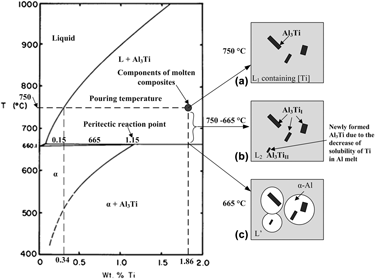Crossref Citations
This article has been cited by the following publications. This list is generated based on data provided by
Crossref.
Watanabe, Yoshimi
Hamada, Takayuki
and
Sato, Hisashi
2016.
Fabrication of novel Al–L12-type Al2.7Fe0.3Ti refiners by spark plasma sintering and their refining performance.
Japanese Journal of Applied Physics,
Vol. 55,
Issue. 1S,
p.
01AG01.
Chen, Gang
Song, Xiaoguo
Hu, Nan
Wang, Heng
and
Tian, Yinfeng
2017.
Effect of initial Ti powders size on the microstructures and mechanical properties of Al3Ti/2024 Al composites prepared by ultrasonic assisted in-situ casting.
Journal of Alloys and Compounds,
Vol. 694,
Issue. ,
p.
539.
Gupta, Rahul
and
Daniel, B.S.S.
2018.
Impression creep behaviour of in-situ Al3Ti reinforced Al alloy composite fabricated by salt-melt reaction technique.
Materials Today: Proceedings,
Vol. 5,
Issue. 9,
p.
16936.
Yang, Cuicui
Liu, Zhiwei
Zheng, Qiaoling
Cao, Yiliang
Dai, Xiaohan
Sun, Liang
Zhao, Jingrui
Xing, Jiandong
and
Han, Qingyou
2018.
Ultrasound assisted in-situ casting technique for synthesizing small-sized blocky Al3Ti particles reinforced A356 matrix composites with improved mechanical properties.
Journal of Alloys and Compounds,
Vol. 747,
Issue. ,
p.
580.
Gupta, Rahul
Chaudhari, G.P.
and
Daniel, B.S.S.
2018.
Strengthening mechanisms in ultrasonically processed aluminium matrix composite with in-situ Al3Ti by salt addition.
Composites Part B: Engineering,
Vol. 140,
Issue. ,
p.
27.
Dinaharan, I.
2018.
Intermetallic Matrix Composites.
p.
167.
Liu, Zhiwei
Cheng, Na
Zheng, Qiaoling
Wu, Jianhua
Han, Qingyou
Huang, Zhifu
Xing, Jiandong
Li, Yefei
and
Gao, Yimin
2018.
Processing and tensile properties of A356 composites containing in situ small-sized Al3Ti particulates.
Materials Science and Engineering: A,
Vol. 710,
Issue. ,
p.
392.
Azarniya, Amir
Azarniya, Abolfazl
Abdollah‐zadeh, Amir
Madaah Hosseini, Hamid Reza
and
Ramakrishna, Seeram
2019.
In Situ Hybrid Aluminum Matrix Composites: A Review of Phase Transformations and Mechanical Aspects.
Advanced Engineering Materials,
Vol. 21,
Issue. 7,
Zeng, Yan
Himmler, David
Randelzhofer, Peter
and
Körner, Carolin
2019.
Microstructures and Mechanical Properties of Al3Ti/Al Composites Produced In Situ by High Shearing Technology.
Advanced Engineering Materials,
Vol. 21,
Issue. 4,
Singh, Ratnakar
Prakash, Ujjwal
Kumar, Deepak
and
Laha, Kinkar
2020.
Microstructure and Mechanical Properties of Forged High Yttria 18Cr-ODS Steels.
Journal of Materials Engineering and Performance,
Vol. 29,
Issue. 10,
p.
6263.
Gong, Y.P.
Ma, S.M.
Hei, H.J.
Ma, Y.
Zhou, B.
Wang, Y.S.
Yu, S.W.
Wang, X.
and
Wu, Y.C.
2020.
Tailoring microstructure and its effect on wear behavior of an Al–7Si alloy reinforced with in situ formed Al3Ti particulates.
Journal of Materials Research and Technology,
Vol. 9,
Issue. 4,
p.
7136.
Sun, Yong-Hui
Yan, Hong
and
Xiong, Jun-Jie
2020.
Al3Ti/ADC12 Composite Synthesized by Ultrasonic Chemistry in Situ Reaction.
Science and Engineering of Composite Materials,
Vol. 27,
Issue. 1,
p.
10.
Reese, C. W.
Gladstein, A.
Fedors, J. M.
De Andrade, V.
Mishra, B.
Shahani, A. J.
and
Taub, A. I.
2020.
In Situ Al-TiC Composites Fabricated by Self-propagating High-Temperature Reaction: Insights on Reaction Pathways and Their Microstructural Signatures.
Metallurgical and Materials Transactions A,
Vol. 51,
Issue. 7,
p.
3587.
Gupta, Rahul
and
Daniel, B. S. S.
2021.
Strengthening Mechanisms in Al3Zr-Reinforced Aluminum Composite Prepared by Ultrasonic Assisted Casting.
Journal of Materials Engineering and Performance,
Vol. 30,
Issue. 4,
p.
2504.
Das, Rahul
Sethi, Duryodhan
Saha Roy, Barnik
Tummala, S.
Kosaraju, S.
Bobba, P.
and
Singh, S.
2021.
Microstructure and mechanical characteristics of an in-situ synthesis of AA7075/TiB2 metal matrix composite.
E3S Web of Conferences,
Vol. 309,
Issue. ,
p.
01149.
Zhang, Ningbo
Han, Xiuli
Sun, Dongli
Liu, Hao
Xue, Wei
Ju, Boyu
and
Wu, Gaohui
2021.
Crystallographic orientation relationships and interfacial structures between reinforcement and matrix phases in an in situ (Ti, Nb)B/Ti2AlNb composite.
Applied Surface Science,
Vol. 542,
Issue. ,
p.
148592.
Vidyuk, Tomila M.
Dudina, Dina V.
Korchagin, Michail A.
Gavrilov, Alexander I.
Ukhina, Arina V.
Bulanova, Uliana E.
Legan, Mikhail A.
Novoselov, Aleksey N.
Esikov, Maksim A.
and
Anisimov, Alexander G.
2021.
Manufacturing of TiC-Cu composites by mechanical milling and spark plasma sintering using different carbon sources.
Surfaces and Interfaces,
Vol. 27,
Issue. ,
p.
101445.
Zhou, Siyu
Wu, Ke
Yang, Guang
Wu, Bin
Qin, Lanyun
Wu, Hao
and
Yang, Chaoyue
2022.
Microstructure and mechanical properties of wire arc additively manufactured 205A high strength aluminum alloy: The comparison of as-deposited and T6 heat-treated samples.
Materials Characterization,
Vol. 189,
Issue. ,
p.
111990.
Liu, G.F.
and
Chen, T.J.
2022.
Effect of ball-milling time on microstructures and mechanical properties of heterogeneity-improved heterostructured 2024Al alloys fabricated through powder thixoforming.
Materials Chemistry and Physics,
Vol. 291,
Issue. ,
p.
126684.
Liu, G.F.
and
Chen, T. J.
2022.
Synthesis of Heterogeneity-Improved Heterostructured 2024al Alloy with Excellent Synergy of Strength and Ductility Via Powder Thixoforming.
SSRN Electronic Journal ,
